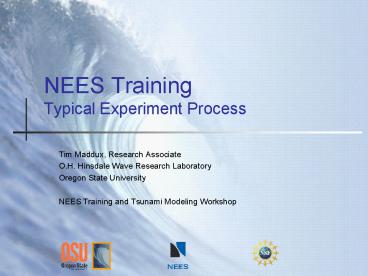NEES Training Typical Experiment Process - PowerPoint PPT Presentation
1 / 13
Title:
NEES Training Typical Experiment Process
Description:
HWRL available for NEES shared use projects. Mostly NSF-funded NEES research projects ... Swash zone dynamics. Safety. Weekly safety reviews. Policies in place for ... – PowerPoint PPT presentation
Number of Views:45
Avg rating:3.0/5.0
Title: NEES Training Typical Experiment Process
1
NEES TrainingTypical Experiment Process
- Tim Maddux, Research Associate
- O.H. Hinsdale Wave Research Laboratory
- Oregon State University
- NEES Training and Tsunami Modeling Workshop
2
Introduction
- HWRL available for NEES shared use projects
- Mostly NSF-funded NEES research projects
- Individual investigator
- Small group
- Grand challenge
- Payload
- Example project CROSSTEX
- Walkthrough of experiment or project process from
proposal to data release
3
Our example CROSSTEX
- What is CROSSTEX?
- Cross-Shore Sediment Transport Experiment
- Funded by NSF, ONR, Oregon SeaGrant
- Proposals submitted by 3 groups
- 11 principal investigators
- 7 institutions
- Approved as a NEES shared use project
- Project phases
- 2002-2003 Planning, proposal writing
- 2004 Proposal acceptance, preparation,
development - 2005 Experiments
- 2006-2007 Analysis and model development
- 2008 Data sharing and public availability
4
The O.H. Hinsdale Wave Research Laboratory (HWRL)
5
Collaborative projects
- Large scale facilities at HWRL
- Tsunami Wave Basin
- Large Wave Flume
- Large scale ? high fixed costs
- Construction
- Deployment
- Testing time
- Advantages of small group over individual
investigator - Mitigate costs with collaborative design
- Variety of experiments with same overall basin
configuration
6
Collaborative projects
- Example CROSSTEX
- Need for laboratory study
- Simplification
- Control
- Need for large scale
- Realistic turbulence
- Realistic sediment response
- Wide range of interesting scales
- Turbulent events and sand grains
- Wave climate and sand bars
- Plan at proposal stage for experimental
observations by independent sub-groups - Four areas of focus
- Wave bottom boundary layers and ripples
- Surf zone turbulence and sediment suspension
- Sandbar migration
- Swash zone dynamics
7
Safety
- Weekly safety reviews
- Policies in place for
- Heavy equipment operations
- Cranes
- Forklifts
- Other custom equipment
- Confined spaces
- Overhead hazards
- Falling hazards
- Diving / SCUBA certification
- Driving University vehicles
- Protective gear
- Head, eyes, ears, hands, lungs
- Safety / metrology supplement
8
Experimental design
- Communication
- Access to HWRL expertise
- Listserv
- Site specifications database
- Plan
- Model design and setup
- Instrumentation deployment
- Instrumentation recovery
- Materials and supplies
- Outside instrumentation
- Considerations
- Development
- Lead time
- Outside contractors
- Quotes and estimates
9
Experimental design
- Example CROSSTEX
- Planning meetings
- 2004 Ocean Sciences, Portland
- 2005 AGU Fall Meeting, San Francisco
- Outside instrumentation
- Deployment discussions and plans over 6 months
before arrival - Physical deployment
- Compatibility with existing gear
- Synchronization of equipment
- In-house instrumentation
- Reusable deployments where possible to save setup
time
10
Logistics
- Plan early (months ahead) for
- Housing
- Deliveries
- Equipment
- Instruments
- Exceptionally large items
- (again safety is an issue)
- Climate-controlled space
- Lab floor space
- Network connectivity
11
Running waves
- Expect about 1 run / hr for scientific research
projects - 6-8 runs / day, depending on specifics of each
project - Example CROSSTEX
- Independent control of wavemaker by each group
- Control periods lasting from 1 week to 1 month
- Changeover time 1 week
- Groups not in control often still participating
and gathering data
12
Data archival and sharing
- Before data acquisition
- Initialization of project in data archive
- Setup of experiments
- Tentative plan for trials
- Make full use of available tags to populate data
headers - After data acquisition
- Immediate access to data for principal
researchers - Transfer of run-time notes into project
metadata - Checking and post-processing of raw data and
uploading of intermediate and final data sets - Long term access to data for community
- Example CROSSTEX
- Data release after 2 years to public
13
Payload projects
- Projects of opportunity
- Additional chances to take advantage of existing
setup already paid for by collaborative group - Example CROSSTEX
- Experimental phase complete Fall 2005
- Add-on study of dune erosion and overtopping
- Oregon Sea Grant
- USACE
- USGS
- Complementary to main phase of CROSSTEX
- New observations onshore of the surf zone
- New techniques using stereo video































